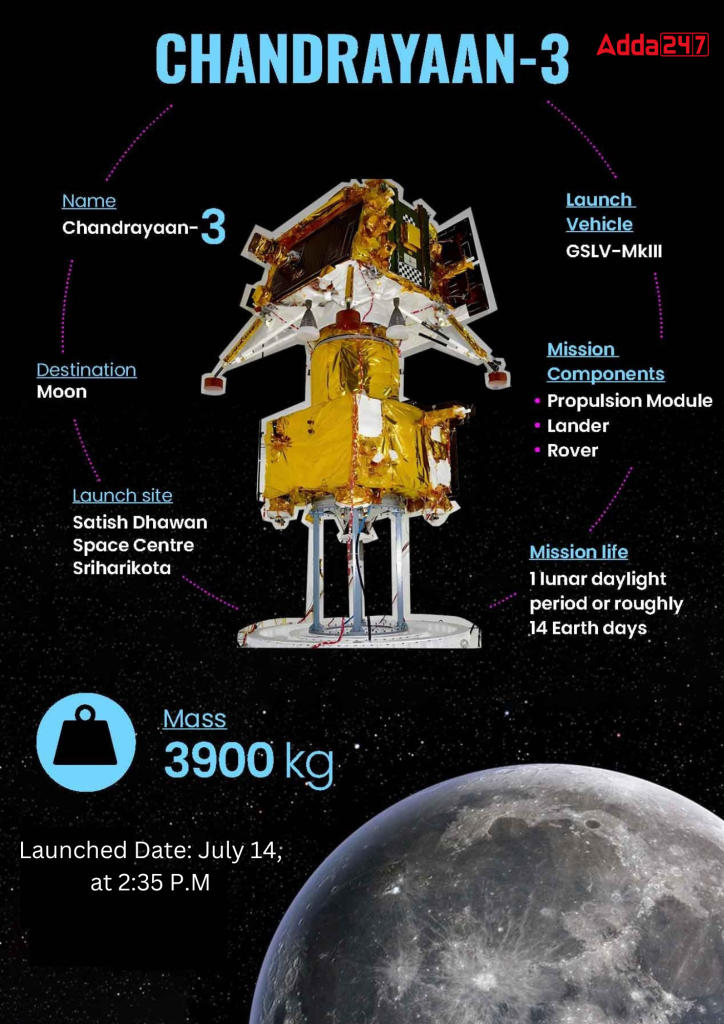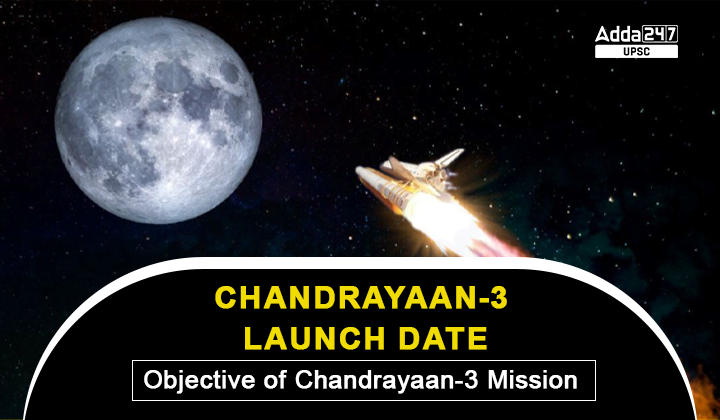Table of Contents
In a remarkable display of ambition and determination, India’s Chandrayaan-3 mission has taken flight from Sriharikota in Andhra Pradesh, carrying the hopes of an entire nation. If successful, the mission will solidify India’s position as the fourth country to achieve a controlled landing on the moon, following the footsteps of Russia, the United States, and China.
The lunar lander, Vikram, is perched atop the mighty Mark 3 heavy-lift launch vehicle, affectionately dubbed the Bahubali rocket. The spacecraft’s journey from Earth to the moon is estimated to take approximately a month, with the anticipated landing scheduled for August 23. Once on the lunar surface, Vikram will operate for one lunar day, equivalent to 14 Earth days.
What Is Chandrayaan-3?
Chandrayaan-3 is the third lunar exploration mission by the Indian Space Research Organisation (ISRO). It will consist of a lander and a rover similar to Chandrayaan-2, but would not have an orbiter. Its propulsion module will behave like a communications relay satellite. The propulsion module will carry the lander and rover configuration until the spacecraft is in a 100 km lunar orbit.
Follow-On Mission: Chandrayaan-3 is a follow-on mission to Chandrayaan-2 to demonstrate end-to-end capability in safe landing and roving on the lunar surface.
Lander, Rover, And Propulsion Module: Chandrayaan-3 interplanetary mission has three major modules: the Propulsion module, Lander module, and Rover.
- Lander payloads:
-
-
- Chandra’s Surface Thermophysical Experiment (ChaSTE) to measure the thermal conductivity and temperature;
- The instrument for Lunar Seismic Activity (ILSA) for measuring the seismicity around the landing site is; Langmuir Probe (LP) to estimate the plasma density and its variations.
- A passive Laser Retroreflector Array from NASA is accommodated for lunar laser ranging studies.
-
- Rover payloads:
-
-
-
- Alpha Particle X-ray Spectrometer (APXS) and
- Laser Induced Breakdown Spectroscope (LIBS) for deriving the elemental composition in the vicinity of the landing site.
-
-
- Propulsion Module:
-
-
- The propulsion module will carry the lander and rover configuration till the 100km lunar orbit.
- The propulsion module has a Spectropolarimetry of HAbitable Planet Earth (SHAPE) payload to study the spectral and polarimetric measurements of Earth from the lunar orbit.
-
Launcher: Chandrayaan-3 will be launched by GSLV MkIII from SDSC, Sriharikota.
List of Indian Satellites Launched In India Download PDF
Chandryaan-3
- Chandrayaan-3 is the third lunar exploration mission by the Indian Space Research Organisation (ISRO)
- The mission has six scientific payloads and a seventh instrument, on the propulsion module which will profile the signs of life on earth
- It will consist of a lander and a rover similar to Chandrayaan-2, but would not have an orbiter. Its propulsion module will behave like a communications relay satellite
- The propulsion module will carry the lander and rover configuration until the spacecraft is in a 100 km lunar orbit
- Chandrayaan-3 interplanetary mission has three major modules: the Propulsion module, Lander module, and Rover
- Chandrayaan-3 mission is one of the closest to the lunar south pole mission to date, a region of the moon that has been found to be geologically unique and host to spots in permanent shadow
Chandryaan-3 and Artemis Accord
- Recently, before the scheduled Chandrayaan-3 launch, India also signed the NASA-led Artemis Accords aiming for peaceful human and robotic exploration of the moon
- While the immediate benefits of the accords accrue to human spaceflight, the data from Chandrayaan-3 may be useful for future Artemis human landings too.
Chandrayaan-3 Launch Date
The launch of Chandrayaan-3 is scheduled for July 14, 2023, at 2:35 pm IST. The launch will take place from the Satish Dhawan Space Centre in Sriharikota, India. The launch date was announced by the Indian Space Research Organisation (ISRO) on May 2, 2023. The launch was originally scheduled for December 2022 but was delayed due to technical reasons. The Chandrayaan-3 mission is a follow-on to Chandrayaan-2, which was launched in 2019.
What is ISRO’s IMAT Test for Gaganyaan Program? | Parachute Drop Test
What Is the EMI-EMC Test?
- EMI-EMC (Electro – Magnetic Interference/ Electro – Magnetic Compatibility) test is conducted for satellite missions to ensure the functionality of the satellite subsystems in the space environment and their compatibility with the expected electromagnetic levels.
- This test is a major milestone in the realization of the satellites.
- Chandrayaan-3 interplanetary mission has three major modules: the Propulsion module, Lander module, and Rover. The mission’s complexity calls for establishing radio-frequency (RF) communication links between the modules.
- During the Chandrayaan-3 lander EMI/EC test, Launcher compatibility, Antenna Polarization of all RF systems, Standalone auto compatibility tests for orbital and powered descent mission phases, and Lander & Rover compatibility tests for post landing mission phase were ensured. The performance of the systems was satisfactory.
ISRO Launched SSLV D2 Successfully From Sriharikota
Chandrayaan-3 Launch Vehicle
Here is some information about the Chandrayaan-3 Launch Vehicle:
- The Chandrayaan-3 Launch Vehicle is a Geosynchronous Satellite Launch Vehicle Mark III (GSLV Mk III) rocket, which is also known as the Launch Vehicle Mark-3 (LVM-3).
- The GSLV Mk III is a three-stage heavy-lift launch vehicle developed by the Indian Space Research Organisation (ISRO).
- The first stage of the GSLV Mk III is powered by two Vikas engines, the second stage is powered by a single C25 engine, and the third stage is powered by a single cryogenic engine.
- The Chandrayaan-3 Launch Vehicle is capable of lifting a payload of up to 4,000 kg into a geosynchronous transfer orbit.
- The launch of Chandrayaan-3 is scheduled for July 14, 2023, at 2:35 pm IST.
- The launch will take place from the Satish Dhawan Space Centre in Sriharikota, India.
The Chandrayaan-3 Launch Vehicle is a critical component of the Chandrayaan-3 mission. The launch vehicle will be responsible for carrying the Chandrayaan-3 spacecraft into orbit around the Moon. The spacecraft will then use its own propulsion system to land on the lunar surface. The success of the Chandrayaan-3 Launch Vehicle is essential for the success of the Chandrayaan-3 mission.
If the launch vehicle fails, the Chandrayaan-3 spacecraft will not be able to reach the Moon. The Chandrayaan-3 Launch Vehicle is a major technological achievement for ISRO. The launch vehicle is the most powerful rocket that India has ever developed. The success of the Chandrayaan-3 Launch Vehicle will demonstrate India’s capabilities in the field of space launch technology.
Objectives for the Chandrayaan-3 Mission
The Chandrayaan-3 mission is a follow-on mission to Chandrayaan-2, India’s first lunar mission to successfully land on the Moon. The primary objectives of Chandrayaan-3 are:
- To demonstrate a safe and soft landing on the lunar surface.
- To demonstrate rover roving on the Moon.
- To conduct in-situ scientific experiments.
The Chandrayaan-3 lander will be similar to the Vikram lander on Chandrayaan-2, with improvements to help ensure a safe landing. The rover will be similar to the Pragyan rover on Chandrayaan-2 but with a new set of scientific instruments. The scientific experiments that will be conducted by the Chandrayaan-3 mission will focus on the following areas:
- Lunar topography and mineralogy.
- Elemental abundance.
- Lunar exosphere.
- Signatures of hydroxyl and water ice.
- Lunar seismicity.
- Lunar surface plasma environment.
The Chandrayaan-3 mission is a critical step in India’s lunar exploration program. It will help to further our understanding of the Moon and its potential resources. The mission will also demonstrate India’s capabilities in space exploration, and help to position the country as a leader in this field. The Chandrayaan-3 mission is scheduled to launch on July 14, 2023.
The lander and rover will land on the Moon’s south pole, which is a region that is thought to be rich in water ice. The mission is expected to last for one year. The Chandrayaan-3 mission is a major undertaking, and it is a testament to the hard work and dedication of the Indian Space Research Organization (ISRO). The mission is sure to make significant contributions to our understanding of the Moon, and it will help to pave the way for future lunar exploration missions.
Problem with Chandryaan-2
- Chandrayaan-2 was launched in July 2019 in the form of an orbiter and a lander Vikram and a rover Pragyan.
- The orbiter entered into orbit around the moon but the surface mission failed when the lander crashed instead of executing a slow descent.
- ISRO later identified a problem in the guidance software and unexpected dispersion in the propulsion system during certain phases of the descent.

UPSC Relevance
- Prelims: Chandryaan-3, Artemis accord, ISRO, Moon
- GS3: Achievements of Indians in science & technology; indigenization of technology and development of new technology.
Practice Question:
- Which of the following countries is a founding member of the Artemis Accord?
- UK
- Canada
- India
- Japan
Select the correct option from the codes given below:
(a) 1, 2 and 3 only
(b) 2 and 3 only
(c) 1, 2 and 4 only
(d) 1, 2, 3 and 4
| ARTEMIS ACCORD |
|
| Indian Space Research Organisation: |
|
Chandrayaan-2 gauges sodium content on Moon’s surface
| Related Articles | |
| Moon Landing 2023 | Aditya L 1 Mission |
| Chandrayaan-3 | Prime Minister Narendra Modi |



 TSPSC Group 1 Question Paper 2024, Downl...
TSPSC Group 1 Question Paper 2024, Downl...
 TSPSC Group 1 Answer key 2024 Out, Downl...
TSPSC Group 1 Answer key 2024 Out, Downl...
 UPSC Prelims 2024 Question Paper, Downlo...
UPSC Prelims 2024 Question Paper, Downlo...




